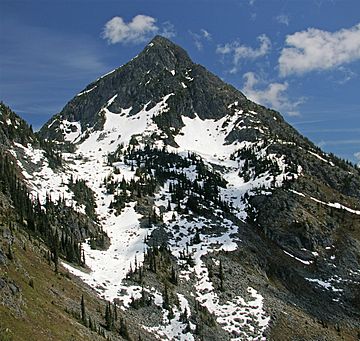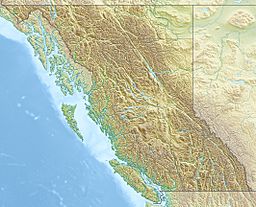Williams Peak (British Columbia) facts for kids
Quick facts for kids Williams Peak |
|
|---|---|

Williams Peak, west aspect
|
|
| Highest point | |
| Elevation | 2,123 m (6,965 ft) |
| Prominence | 793 m (2,602 ft) |
| Parent peak | Foley Peak (2293 m) |
| Geography | |
| Location | British Columbia, Canada |
| Parent range | Skagit Range North Cascades |
| Topo map | NTS 92H/4 |
| Geology | |
| Mountain type | Intrusive |
| Volcanic arc/belt | Pemberton Volcanic Belt |
| Climbing | |
| First ascent | 1908 by James J. McArthur and E.T. de Coeli |
| Easiest route | Scrambling |
Williams Peak is a tall mountain in southwestern British Columbia, Canada. It stands about 2,123-metre (6,965-foot) high. This makes it a very noticeable part of the Cascade Mountains.
The mountain is located near the Chilliwack River valley. It is about 14 km (9 mi) north of the border between Canada and the United States. It's also close to Chilliwack Lake. Williams Peak is the highest point in an area called the South Hope Mountains. This area is part of the larger Skagit Range.
Water from the peak flows into streams that feed the Chilliwack River. The mountain was officially named Williams Peak on April 7, 1955. The first people to climb Williams Peak were James J. McArthur and E.T. de Coeli. They reached the top in July 1908. They climbed using the southwest ridge route.
Contents
What is the Geology of Williams Peak?
Williams Peak is connected to something called the Chilliwack batholith. A batholith is a very large mass of rock that formed deep underground. This rock pushed its way into the area about 26 to 29 million years ago. This happened after big mountain-building events, known as orogenic episodes.
The mountain is also part of the Pemberton Volcanic Belt. This belt is an old chain of volcanoes that have worn down over time. It formed because of a process called subduction. This is when one of Earth's large plates slides under another. In this case, the Farallon Plate began sliding under North America about 29 million years ago.
How did Glaciers Shape Williams Peak?
During the Pleistocene period, which started over two million years ago, huge sheets of ice called glaciers covered the land. These glaciers moved forward and then melted back many times. As they moved, they scraped and shaped the landscape. They left behind piles of rock and debris.
The valleys in this area often have a "U" shape. This shape was carved out by these powerful glaciers. The combination of land being pushed up (uplift) and cracks in the Earth's crust (faulting), along with glaciation, created the tall peaks and deep valleys we see today in the North Cascades.
The North Cascades region has some of the most rugged land in the Cascade Range. You can see jagged peaks, sharp ridges, deep glacial valleys, and tall granite spires. These geological events created a wide variety of landscapes. They also led to big changes in elevation and different climates. This is why there are so many different types of plants and animals in the ecoregions here.
What is the Climate Like at Williams Peak?
Williams Peak has a marine west coast climate. This type of climate is found in western North America. It means the area gets a lot of rain and mild temperatures.
Most weather fronts, which bring changes in weather, start over the Pacific Ocean. They then travel east towards the Cascade Range. When these weather fronts hit the mountains, they are forced to rise. This process is called Orographic lift. As the air rises, it cools and drops its moisture. This causes a lot of rain or snow to fall on the mountains.
Because of this, the Cascade Mountains get a lot of precipitation. This is especially true in the winter, when most of it falls as snow. Temperatures can get very cold, sometimes dropping below −20 °C. With the wind, it can feel even colder, below −30 °C. The best time to climb Williams Peak is usually from July through September. During these months, the weather is most favorable.
What are the Climbing Routes on Williams Peak?
There are several known routes for climbing Williams Peak. These routes are rated by how difficult they are.



